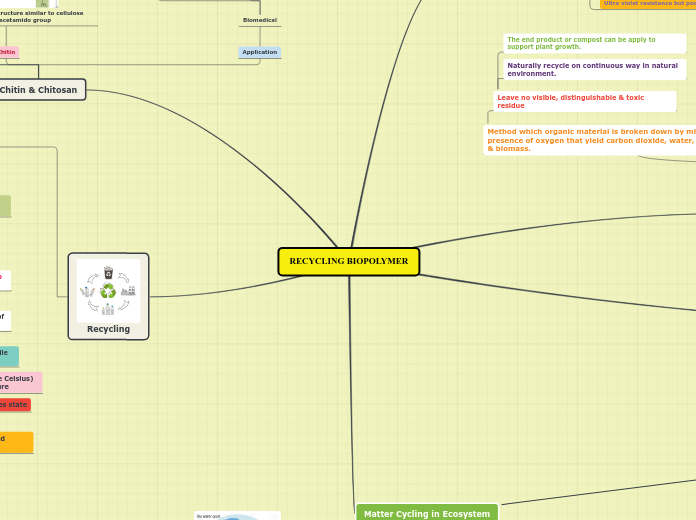RECYCLING BIOPOLYMER
Recycling
Technique to recovered waste plastic material & reuse
Mechanical Recycling
Reprocessing
Agglomeration - crumbs or agglomerates state
Extrusion- produce pellets from recycled material
Washing & Drying
Wash by cold & hot water ( 60 degree Celsius) and dried until less than 0.1% moisture
Shredding
Reduce size of scrap by shredder into smaller pile of plastic flakes.
Sorting
Plastics waste are separated from impurities and different type of plastic grade
Techniques
Eddy current separator - use of electric current to separate non-ferrous material
Induction Sorting- inductive sensor detect types of metal & separated by fast air blast
Chitin & Chitosan
Application
Biomedical
Tissue Engineering
prepared in porous form permitting cell growth into tissue
wound dressing for wound skin
Chitin
Natural polysaccharide- Structure similar to cellulose with OH group replace by acetamido group
Chitosan
N- deacetylated derivative of chitin
Characteristic
Biodegradable
Biocompatible
Nonp toxic
Renewable
Matter Cycling in Ecosystem
Major Ecosystem Component
Biotic
Interaction with biotic component- predation, competition, symbiosis,parasitm
Plants, animals, bacteria/fungi
Producer, consumer & decomposer
Abiotic
water, air, temperature, soil, light level, precipitation, salinity
Nitrogen Cycle
a biogeochemical process which nitrogen is converted into many forms, passing from the atmosphere to the soil to organism and back into the atmosphere
Nitrogen enter the soil and ocean by lightning & nitrogen fixing bacteria
bacteria turn nitrogen gas from the atmosphere into ammonia.
In nitrification, a host of soil bacteria participate in turning ammonia into nitrate – the form of nitrogen that can be used by plants and animals
In nitrogen assimilation, plants finally consume the nitrates made by soil bacteria and use them to make nucleotides, amino acids, and other vital chemicals for life.
In the final step of the nitrogen cycle, anaerobic bacteria can turn nitrates back into nitrogen gas.
This process, like the process of turning nitrogen gas into ammonia, must happen in the absence of oxygen
ammonification is performed by soil bacteria which decompose dead plants and animals &the decomposers break down amino acids and nucleic acids into nitrates and ammonia and back into the soil. The ammonia taken up by plants and nitrifying bacteria.
Carbon Cycle
nature's reusing carbon atoms, which travel from the atmosphere into organisms in the Earth and then back into the atmosphere over and over again
Carbon enters the atmosphere as carbon dioxide from respiration (breathing) and combustion (burning).
Carbon dioxide is absorbed by producers (life forms that make their own food (plants) to make carbohydrates in photosynthesis . These producers then put off oxygen
Animals feed on the plants & most of the carbon these animals consume exhaled as carbon dioxide through the process of respiration. The animals and plants then eventually die.
The dead organisms (dead animals and plants) are eaten by decomposers in the ground. The carbon that was in their bodies is then returned to the atmosphere as carbon dioxide
Water Cycle
The natural water cycle moves water from the earth to the atmosphere - and back again
Evaporation- sun heat the water, turning it into water vapor which rises into the air.
Transpiration-water vapor release into the air from people, animal & plant when warmed by sun
Condensation- cooled water vapor in air form tiny water droplets in sky
Precipitation- when water droplets fall from sky as rain, snow.
Percolation-water seeps deeper into tiny spaces in the soil and rock.
Phosphate Cycle
Phosphorus in soil can end up in waterways and eventually oceans. Once there, it can be incorporated into sediments over time.
Within the soil, organic forms of phosphate can be made available to plants by bacteria that break down organic matter to inorganic forms of phosphorus. This process is known as mineralisation.
Plants take up inorganic phosphate from the soil. The plants then be consumed by animals. Once in the plant or animal, the phosphate is incorporated into organic molecules such as DNA. When the plant or animal dies, it decays, and the organic phosphate is returned to the soil.
Phosphorus moves in a cycle through rocks, water, soil and sediments and organisms.
Composting
Advantages
Save landfill space
low leachate & methane gas production
Enriches soil by production of beneficial bacteria & fungi to create a rich nutrient material in plantation
Material to compost
Dairy
Paper goods
Fruits & Vegetables
Method which organic material is broken down by microorganisms in the presence of oxygen that yield carbon dioxide, water, inorganic compounds & biomass.
Leave no visible, distinguishable & toxic residue
Naturally recycle on continuous way in natural environment.
The end product or compost can be apply to support plant growth.
Biopolymer Characteristic
Ultra violet resistance but poor acid & bases resistance
Biocompatible suit for medical application
Non- toxic
Soluble in Chloroform









